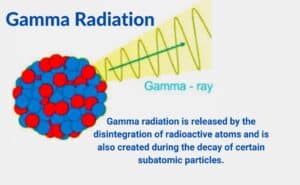Gamma radiation, an enigmatic and powerful form of electromagnetic radiation, occupies a unique niche in the realm of physics. Its origins trace back to the interactions of atomic nuclei, where it emerges as a product of radioactive decay, particularly during the transitions of excited nuclear states. Yet, the question arises: Is it possible to create gamma radiation in a laboratory setting? The answer, rooted in both theoretical and experimental practices, underscores the intricate relationship between fundamental principles of physics and the practicalities of technological innovation.
To elucidate this topic, one must first understand the fundamental properties of gamma radiation. Distinct from alpha and beta particles, gamma rays possess no mass and no electric charge, manifesting as high-energy photons. Their wavelengths range from 0.01 to 10 nanometers, situating them at the far end of the electromagnetic spectrum, beyond X-rays and ultraviolet light. This remarkable energy translates into the capability to penetrate matter, a characteristic that renders gamma rays both a subject of fascination and a tool for applications in various fields, including medicine, industry, and astrophysics.
Historically, the production of gamma radiation has been intrinsically linked to natural phenomena, primarily through radioactive isotopes such as cobalt-60 and cesium-137. These isotopes emit gamma radiation spontaneously as they decay, illustrating a primal process that underscores the stability and instability of atomic nuclei. However, the quest to generate gamma radiation artificially can be traced back to the early 20th century, where physicists began to manipulate atomic particles in meticulously controlled environments.
The core methodology for laboratory-generated gamma radiation typically involves the use of particle accelerators. These sophisticated devices harness electric fields to accelerate charged particles to high velocities, ultimately enabling them to collide with target materials. When these high-energy particles, commonly protons or electrons, interact with atomic nuclei, they can induce nuclear reactions resulting in the emission of gamma rays. Such processes take center stage in institutions dedicated to nuclear physics research.
One prevalent technique utilized in laboratories is the photonuclear reaction, where high-energy gamma photons are used to bombard a target material. In this scenario, when the gamma photons strike the nuclei of the target atoms, they impart sufficient energy to overcome the nuclear binding forces, leading to nuclear excitations and the subsequent release of additional photons in the gamma spectrum. This method, while effective, requires an intricate understanding of the target nuclei’s energy states, as the efficiency of gamma production is heavily dependent on the isotopes involved.
In addition to photonuclear reactions, positron-electron annihilation in particle accelerators serves as another avenue for gamma photon generation. When a positron, the antimatter counterpart of an electron, collides with an electron, their annihilation generates pairs of gamma photons. This annihilation not only produces gamma radiation but also provides insights into the fundamental symmetries of the universe and the properties of matter and antimatter.
Moreover, the environmental safety and ethical considerations surrounding the creation and utilization of gamma radiation cannot be overstated. Due to its penetrating power and potential biological implications, strict regulatory frameworks govern the use of radioactive materials and high-energy radiation in laboratories. Institutions employing such technologies must adhere to guidelines implemented by governmental and international bodies, ensuring that research activities are conducted with utmost vigilance and responsibility.
The fascination with gamma radiation extends beyond its practical applications; it touches upon the very fabric of our understanding of the universe. Gamma rays are a significant component of astrophysics, illuminating phenomena such as supernovae, gamma-ray bursts, and the enigmatic nature of dark matter. By investigating these cosmic occurrences, scientists glean insights into the origins of the universe and the fundamental laws governing cosmic evolution. Additionally, the study of gamma radiation bolsters disciplines such as nuclear medicine, where targeted therapies leverage the properties of gamma photons to treat malignancies, illuminating both the benefits and risks associated with such interventions.
In conclusion, the ability to generate gamma radiation in a laboratory setting, while challenging, is a testament to human ingenuity and the relentless pursuit of knowledge. Through the use of sophisticated technology and a comprehensive understanding of nuclear physics, researchers are equipped to explore the intricate dynamics of atomic interactions, advancing our comprehension of both terrestrial and cosmic phenomena. The multifaceted role of gamma radiation—from its production in laboratories to its cosmic occurrences—invites continual investigation and captivates a wide array of scientific disciplines, underscoring the profound implications of this intriguing segment of the electromagnetic spectrum.












